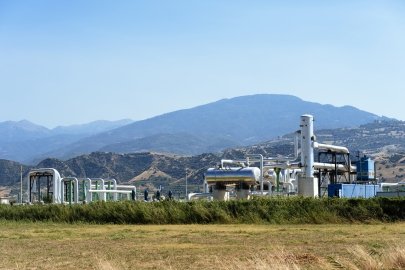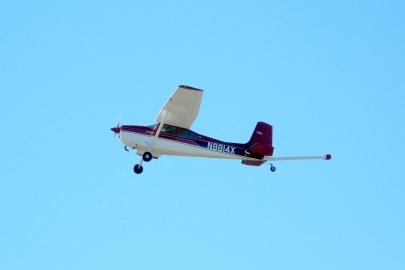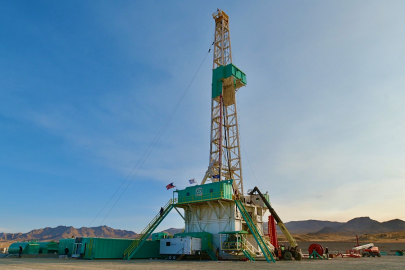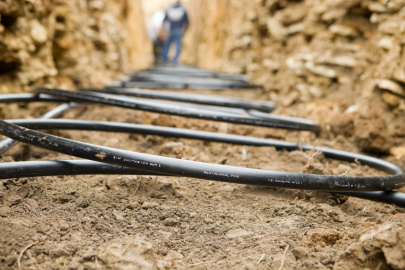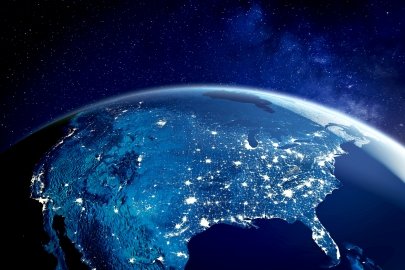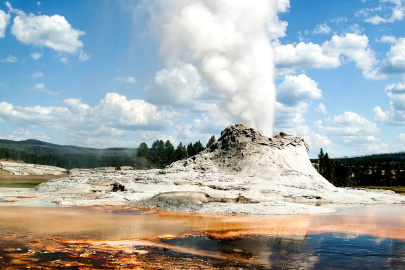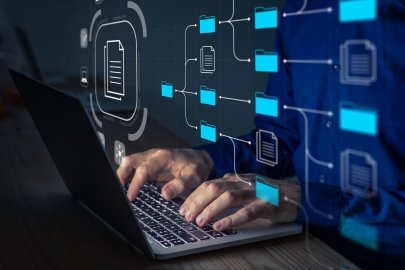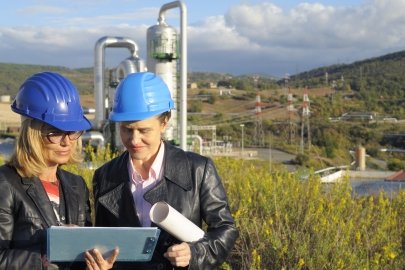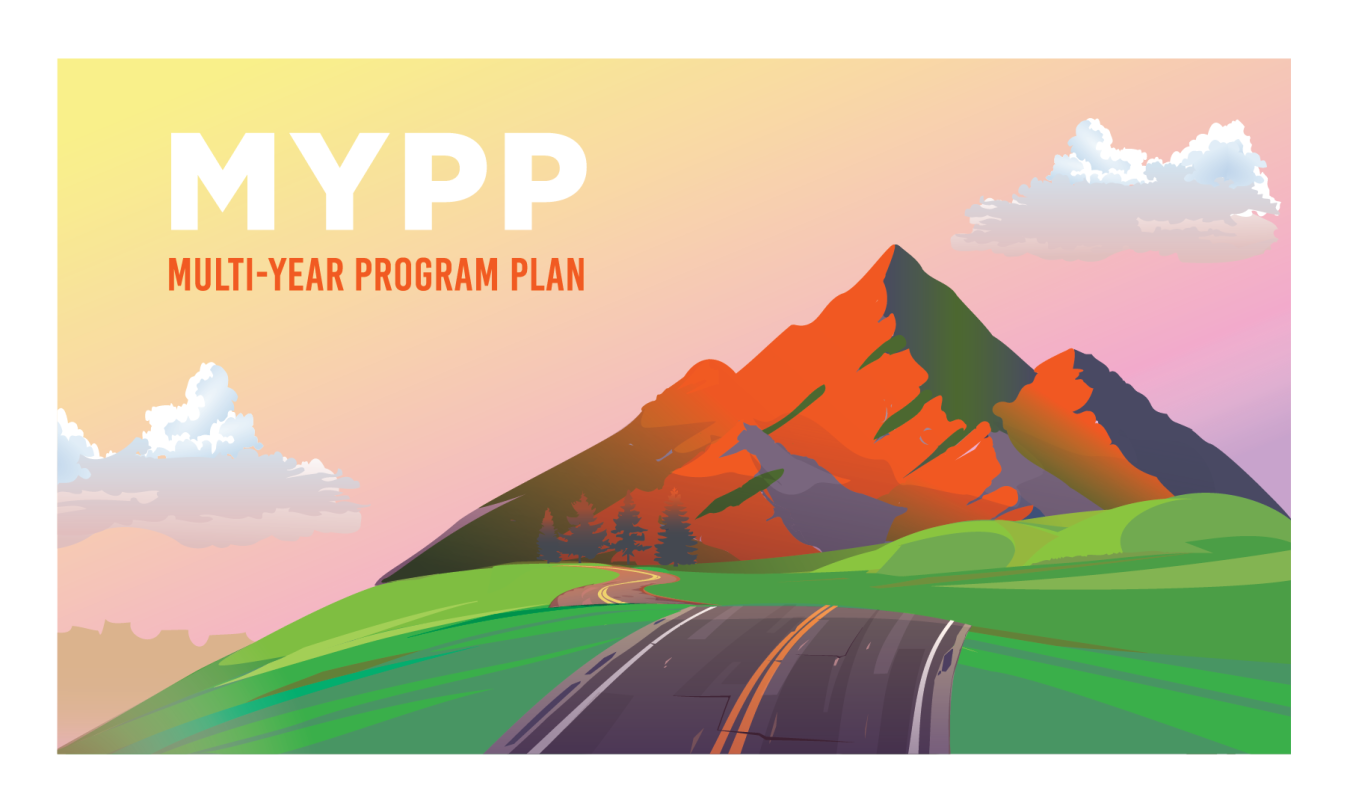
The U.S. Department of Energy’s (DOE) Geothermal Technologies Office’s (GTO) Fiscal Year (FY) 2022-2026 Multi-Year Program Plan (MYPP), building on the findings of the GeoVision analysis, provides a high-level technology plan that focuses on key areas of GTO research to support the growth and long-term contribution of geothermal energy to the U.S. electricity grid and American homes and buildings.
Executive Summary
Geothermal energy—the “heat beneath our feet”—is a firm, flexible source of clean, secure, and reliable domestic energy that can be utilized across industrial, commercial, and residential sectors. Geothermal energy can help us achieve a carbon pollution-free power sector by 2035 and a net-zero emissions economy by 2050, while offering grid stability, greater diversity of affordable energy options, and efficient heating and cooling. Additionally, key geothermal technology and workforce pathways can assist the seamless transfer from oil and gas to renewables.
Secretary Granholm and the former director of the Geothermal Technologies Office (GTO), Susan Hamm, dig into GTO’s Multi-Year Program Plan in their geyser-side chat
The MYPP outlines GTO’s vision and mission, presenting a high-level technology structure for key areas of GTO research starting in FY 2022 and running through the end of FY 2026.
GTO considers the key findings of the GeoVision analysis to be clear evidence of geothermal energy’s role as critical to the nation’s aggressive, zero-carbon energy transformation. Thus, GTO has adopted the following strategic goals to reach geothermal energy’s full potential:
- Strategic Goal 1: Drive toward a carbon-free electricity grid by supplying 60 gigawatts (GW) of enhanced geothermal systems (EGS) and hydrothermal resource deployment by 2050.
- Strategic Goal 2: Decarbonize building heating and cooling loads by capturing the economic potential of 17,500 geothermal district heating installations and by installing geothermal heat pumps in 28 million households nationwide by 2050.
- Strategic Goal 3: Deliver economic, environmental, and social justice advancements through increased geothermal technology deployment.
Read the full executive summary.
View GTO's prior MYPP here: Geothermal Technologies Office Multi-Year Program Plan: 2009-2015 with Program Activities to 2025.
Explore the MYPP
GTO takes an active approach to consistently assessing program activities and effectiveness. GTO’s program evaluation activities ensure progress toward DOE, the Office of Energy Efficiency & Renewable Energy (EERE), and GTO goals, while also ensuring effective stewardship of DOE investments and taxpayer dollars. GTO engages in informal and ongoing program evaluation through staff meetings, project check-in calls, brainstorming discussions, and other activities. In addition, GTO adheres to EERE guidelines for formal evaluations. These EERE guidelines are outlined in two key objectives:
- To assess whether planned technical goals were met, and determine commercialization and market results achieved.
- To identify opportunities to make continuous improvements in programs in order to effectively and efficiently manage public investments.

Augustine, C., Ho, J., Blair, N. (2019). Electric Sector Potential to Penetration. NREL/TP-6A20-71833. Golden, CO: National Renewable Energy Laboratory. Accessed February 9, 2021: https://www.nrel.gov/docs/fy19osti/71833.pdf.
Connelly, E., Peney, M., Milbrandt, A., Roberts, B., Gilroy, N., and Melaina, M. (2020). Resource Assessment for Hydrogen Production. NREL/TP-5400-77198. Golden, CO: National Renewable Energy Laboratory. Accessed February 9, 2021: https://www.nrel.gov/docs/fy20osti/77198.pdf.
Dupriest, F. E., Elks, W. C., Ottesen, S., Pastusek, P. E., Zook, J. R., Aphale, C. R. (2011). Borehole-Quality Design and Practices To Maximize Drill-Rate Performance. Society of Petroleum Engineers. Accessed October 6, 2020 (fee required): https://doi.org/10.2118/134580-MS.
Gallaher, M., Rogozin, A., Petrusa, J. (2010). Retrospective Benefit-Cost Evaluation of U.S. DOE Geothermal Technologies R&D Program Investments: Impacts of a Cluster of Energy Technologies. Research Triangle Park, NC: RTI International for the U.S. Department of Energy Geothermal Technologies Office. Accessed October 6, 2020: /sites/prod/files/2014/02/f7/gtp_benefit-cost_eval_aug2010.pdf.
Gasperikova, E. and Cumming, W. (submitted 2020). “How Geophysics can Help the Geothermal Industry.” Society of Exploration Geophysicists 2020 Conference Proceedings; October 11-16, 2020, virtual. Berkeley, CA: Lawrence Berkeley National Laboratory; Santa Rosa, CA: Cumming Geoscience. https://doi.org/10.1190/segam2020-3425875.1.
Hackett, L., Blankenship, D., Robertson-Tait, A. (2020). “Analysis of Drilling Performance Using PDC Bits, Fallon FORGE Well 21-31.” 45th Workshop on Geothermal Reservoir Engineering Proceedings; February 10-12, 2020, Stanford, California. SGP-TR-216. Albuquerque, NM: Sandia National Laboratories; and Richmond, CA: GeothermEx, Inc., A Schlumberger Company. Accessed October 6, 2020: https://pangea.stanford.edu/ERE/db/GeoConf/papers/SGW/2020/Hackett.pdf.
Linvill, C., Candelaria, J., Elder, C. (2013). The Value of Geothermal Energy Generation Attributes: Aspen Report to Ormat Technologies. Aspen Environmental Group. Accessed October 6, 2020.
Liu, X., Hughes, P., McCabe, K., Spitler, J., Southard, L. (2019). GeoVision Analysis Supporting Task Force Report: Thermal Applications – Geothermal Heat Pumps. ORNL/TM – 2019-052: Oak Ridge, TN. Oak Ridge National Laboratory. Accessed November 22, 2021: https://info.ornl.gov/sites/publications/Files/Pub103860.pdf.
Lowry, T., Finger, J., Carrigan, C., Foris, A., Kennedy, M., Corbet, T., Doughty, C., Pye, S., Sonnenthal, E. (2017). GeoVision Analysis Supporting Task Force Report: Reservoir Maintenance and Development. SAND2017-9977. Albuquerque, NM: Sandia National Laboratories. doi:10.2172/1394062. Accessed October 5, 2020: https://www.osti.gov/biblio/1394062.
Lund, J. and Toth, A. (2020). “Direct Utilization of Geothermal Energy 2020 Worldwide Review.” World Geothermal Congress; April 26–May 2, 2020, Reykjavik, Iceland. WGC01018. Klamath Falls, OR: Oregon Institute of Technology; and Miskolc, Hungary: Ana-Geo Ltd. Accessed October 5, 2020: https://www.geothermal-energy.org/pdf/IGAstandard/WGC/2020/01018.pdf.
McCabe, K., Beckers, K., Young, K., Blair, N. (2019). GeoVision Analysis Supporting Task Force Report: Thermal Applications. NREL/TP-6A20-71715. Golden, CO: National Renewable Energy Laboratory. Accessed November 22, 2021: https://www.nrel.gov/docs/fy19osti/71715.pdf.
Millstein, D., McCall, J., Macknick, J., Nicholson, S., Keyser, D., Jeong, S., and Heath, G. (2019). GeoVision Analysis Supporting Task Force Report: Impacts. Berkeley, CA and Golden, CO: Lawrence Berkeley National Laboratory and National Renewable Energy Laboratory. NREL/TP-6A20-71933. Accessed February 9, 2021: https://www.nrel.gov/docs/fy19osti/71933.pdf.
Simmons, S., Kirby, S., Verplanck, P., Kelley, K. (2018). “Strategic and Critical Elements in Produced Geothermal Fluids from Nevada and Utah” 43rd Workshop on Geothermal Reservoir Engineering Proceedings; February 12-14, 2018, Stanford, California. SGP-TR-213. Salt Lake City, UT: University of Utah, and Salt Lake City, UT/Denver, CO: United States Geological Survey. Accessed October 6, 2020: https://www.osti.gov/servlets/purl/1433889.
Snyder, D., Beckers, K., and Young, K. (2017). “Update on Geothermal Direct-Use Installations in the United States”. 42nd Workshop on Geothermal Reservoir Engineering Proceedings; February 13-15, 2017, Stanford, California. SGP-TR-212. Golden, CO: National Renewable Energy Laboratory. Accessed February 8, 2021: https://pangea.stanford.edu/ERE/pdf/IGAstandard/SGW/2017/Snyder.pdf.
Stringfellow, W., Dobson, P. (2020). Retrospective on Recent DOE-Funded Studies Concerning the Extraction of Rare Earth Elements & Lithium from Geothermal Brines. Berkeley, CA. Lawrence Berkeley National Laboratory. LBNL-2001359. Accessed February, 25, 2021. https://www.osti.gov/biblio/1667374.
U.S. Department of Energy, Geothermal Technologies Program. (2011). Exploration Technologies: Technology Needs Assessment. Prepared by Energetics. Accessed October 5, 2020: /sites/prod/files/2014/02/f7/iet_needs_assessment_06-2011.pdf.
U.S. Department of Energy. (2019). GeoVision: Harnessing the Heat Beneath our Feet. DOE/EE-1306. U.S. Department of Energy, Washington, D.C. Accessed October 1, 2020: /eere/geothermal/articles/geovision-harnessing-heat-beneath-our-feet.
U.S. Energy Information Administration. (2015). Annual Energy Outlook 2015 with projections to 2040. DOE/EIA-0383(2015). Washington, D.C.: U.S. Energy Information Administration. Accessed October 5, 2020: https://digital.library.unt.edu/ark:/67531/metadc948782/.
U.S. Energy Information Administration. (2020). U.S. Oil and Natural Gas Wells by Production Rate. DOE/EIA-0383. Washington, D.C.: U.S. Energy Information Administration. Accessed February 7, 2021: https://www.eia.gov/petroleum/wells/.
Wall, A., Young, K. (2016). Doubling Geothermal Generation Capacity by 2020: A Strategic Analysis. NREL/TP-6A20-64925. Golden, CO: National Renewable Energy Laboratory. Accessed October 6, 2020: /sites/prod/files/2016/01/f28/NREL%20Doubling%20Geothermal%20Capacity.pdf.
Young, K., Levine, A., Cook, J., Heimiller, D., Ho, J. (2019). GeoVision Analysis Supporting Task Force Report: Barriers. Golden, CO. National Renewable Energy Laboratory. NREL/PR-6A20-71641. Accessed October 6, 2020: https://www.nrel.gov/docs/fy19osti/71641.pdf.
Wendt, D. S., Neupane, G., Davidson, C. L., Zheng, R., and Bearden, M. A. (2018). GeoVision Analysis Supporting Task Force Report: Geothermal Hybrid Systems. INL/EXT-17-42891 and PNNL-27386. Idaho Falls, ID: Idaho National Laboratory; and Richland, WA: Pacific Northwest National Laboratory. doi:10.2172/1460735. Accessed October 5, 2020: https://www.osti.gov/servlets/purl/1460735.
The GTO e-newsletter brings funding opportunities, events, publications, and activities directly to your inbox.




